12: Charcoal Drawing
- Page ID
- 63709
\( \newcommand{\vecs}[1]{\overset { \scriptstyle \rightharpoonup} {\mathbf{#1}} } \)
\( \newcommand{\vecd}[1]{\overset{-\!-\!\rightharpoonup}{\vphantom{a}\smash {#1}}} \)
\( \newcommand{\id}{\mathrm{id}}\) \( \newcommand{\Span}{\mathrm{span}}\)
( \newcommand{\kernel}{\mathrm{null}\,}\) \( \newcommand{\range}{\mathrm{range}\,}\)
\( \newcommand{\RealPart}{\mathrm{Re}}\) \( \newcommand{\ImaginaryPart}{\mathrm{Im}}\)
\( \newcommand{\Argument}{\mathrm{Arg}}\) \( \newcommand{\norm}[1]{\| #1 \|}\)
\( \newcommand{\inner}[2]{\langle #1, #2 \rangle}\)
\( \newcommand{\Span}{\mathrm{span}}\)
\( \newcommand{\id}{\mathrm{id}}\)
\( \newcommand{\Span}{\mathrm{span}}\)
\( \newcommand{\kernel}{\mathrm{null}\,}\)
\( \newcommand{\range}{\mathrm{range}\,}\)
\( \newcommand{\RealPart}{\mathrm{Re}}\)
\( \newcommand{\ImaginaryPart}{\mathrm{Im}}\)
\( \newcommand{\Argument}{\mathrm{Arg}}\)
\( \newcommand{\norm}[1]{\| #1 \|}\)
\( \newcommand{\inner}[2]{\langle #1, #2 \rangle}\)
\( \newcommand{\Span}{\mathrm{span}}\) \( \newcommand{\AA}{\unicode[.8,0]{x212B}}\)
\( \newcommand{\vectorA}[1]{\vec{#1}} % arrow\)
\( \newcommand{\vectorAt}[1]{\vec{\text{#1}}} % arrow\)
\( \newcommand{\vectorB}[1]{\overset { \scriptstyle \rightharpoonup} {\mathbf{#1}} } \)
\( \newcommand{\vectorC}[1]{\textbf{#1}} \)
\( \newcommand{\vectorD}[1]{\overrightarrow{#1}} \)
\( \newcommand{\vectorDt}[1]{\overrightarrow{\text{#1}}} \)
\( \newcommand{\vectE}[1]{\overset{-\!-\!\rightharpoonup}{\vphantom{a}\smash{\mathbf {#1}}}} \)
\( \newcommand{\vecs}[1]{\overset { \scriptstyle \rightharpoonup} {\mathbf{#1}} } \)
\( \newcommand{\vecd}[1]{\overset{-\!-\!\rightharpoonup}{\vphantom{a}\smash {#1}}} \)
\(\newcommand{\avec}{\mathbf a}\) \(\newcommand{\bvec}{\mathbf b}\) \(\newcommand{\cvec}{\mathbf c}\) \(\newcommand{\dvec}{\mathbf d}\) \(\newcommand{\dtil}{\widetilde{\mathbf d}}\) \(\newcommand{\evec}{\mathbf e}\) \(\newcommand{\fvec}{\mathbf f}\) \(\newcommand{\nvec}{\mathbf n}\) \(\newcommand{\pvec}{\mathbf p}\) \(\newcommand{\qvec}{\mathbf q}\) \(\newcommand{\svec}{\mathbf s}\) \(\newcommand{\tvec}{\mathbf t}\) \(\newcommand{\uvec}{\mathbf u}\) \(\newcommand{\vvec}{\mathbf v}\) \(\newcommand{\wvec}{\mathbf w}\) \(\newcommand{\xvec}{\mathbf x}\) \(\newcommand{\yvec}{\mathbf y}\) \(\newcommand{\zvec}{\mathbf z}\) \(\newcommand{\rvec}{\mathbf r}\) \(\newcommand{\mvec}{\mathbf m}\) \(\newcommand{\zerovec}{\mathbf 0}\) \(\newcommand{\onevec}{\mathbf 1}\) \(\newcommand{\real}{\mathbb R}\) \(\newcommand{\twovec}[2]{\left[\begin{array}{r}#1 \\ #2 \end{array}\right]}\) \(\newcommand{\ctwovec}[2]{\left[\begin{array}{c}#1 \\ #2 \end{array}\right]}\) \(\newcommand{\threevec}[3]{\left[\begin{array}{r}#1 \\ #2 \\ #3 \end{array}\right]}\) \(\newcommand{\cthreevec}[3]{\left[\begin{array}{c}#1 \\ #2 \\ #3 \end{array}\right]}\) \(\newcommand{\fourvec}[4]{\left[\begin{array}{r}#1 \\ #2 \\ #3 \\ #4 \end{array}\right]}\) \(\newcommand{\cfourvec}[4]{\left[\begin{array}{c}#1 \\ #2 \\ #3 \\ #4 \end{array}\right]}\) \(\newcommand{\fivevec}[5]{\left[\begin{array}{r}#1 \\ #2 \\ #3 \\ #4 \\ #5 \\ \end{array}\right]}\) \(\newcommand{\cfivevec}[5]{\left[\begin{array}{c}#1 \\ #2 \\ #3 \\ #4 \\ #5 \\ \end{array}\right]}\) \(\newcommand{\mattwo}[4]{\left[\begin{array}{rr}#1 \amp #2 \\ #3 \amp #4 \\ \end{array}\right]}\) \(\newcommand{\laspan}[1]{\text{Span}\{#1\}}\) \(\newcommand{\bcal}{\cal B}\) \(\newcommand{\ccal}{\cal C}\) \(\newcommand{\scal}{\cal S}\) \(\newcommand{\wcal}{\cal W}\) \(\newcommand{\ecal}{\cal E}\) \(\newcommand{\coords}[2]{\left\{#1\right\}_{#2}}\) \(\newcommand{\gray}[1]{\color{gray}{#1}}\) \(\newcommand{\lgray}[1]{\color{lightgray}{#1}}\) \(\newcommand{\rank}{\operatorname{rank}}\) \(\newcommand{\row}{\text{Row}}\) \(\newcommand{\col}{\text{Col}}\) \(\renewcommand{\row}{\text{Row}}\) \(\newcommand{\nul}{\text{Nul}}\) \(\newcommand{\var}{\text{Var}}\) \(\newcommand{\corr}{\text{corr}}\) \(\newcommand{\len}[1]{\left|#1\right|}\) \(\newcommand{\bbar}{\overline{\bvec}}\) \(\newcommand{\bhat}{\widehat{\bvec}}\) \(\newcommand{\bperp}{\bvec^\perp}\) \(\newcommand{\xhat}{\widehat{\xvec}}\) \(\newcommand{\vhat}{\widehat{\vvec}}\) \(\newcommand{\uhat}{\widehat{\uvec}}\) \(\newcommand{\what}{\widehat{\wvec}}\) \(\newcommand{\Sighat}{\widehat{\Sigma}}\) \(\newcommand{\lt}{<}\) \(\newcommand{\gt}{>}\) \(\newcommand{\amp}{&}\) \(\definecolor{fillinmathshade}{gray}{0.9}\)Charcoal
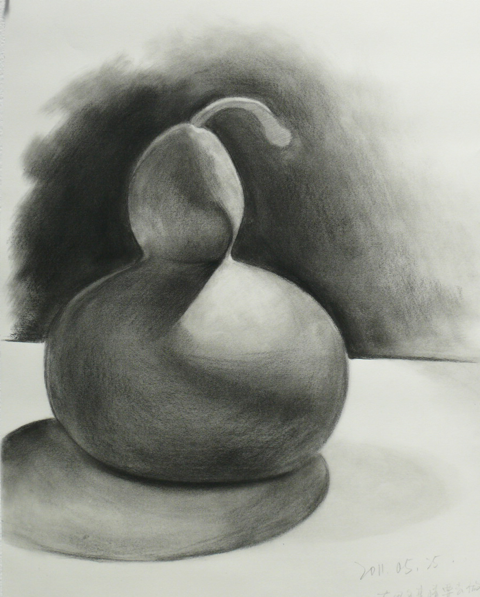
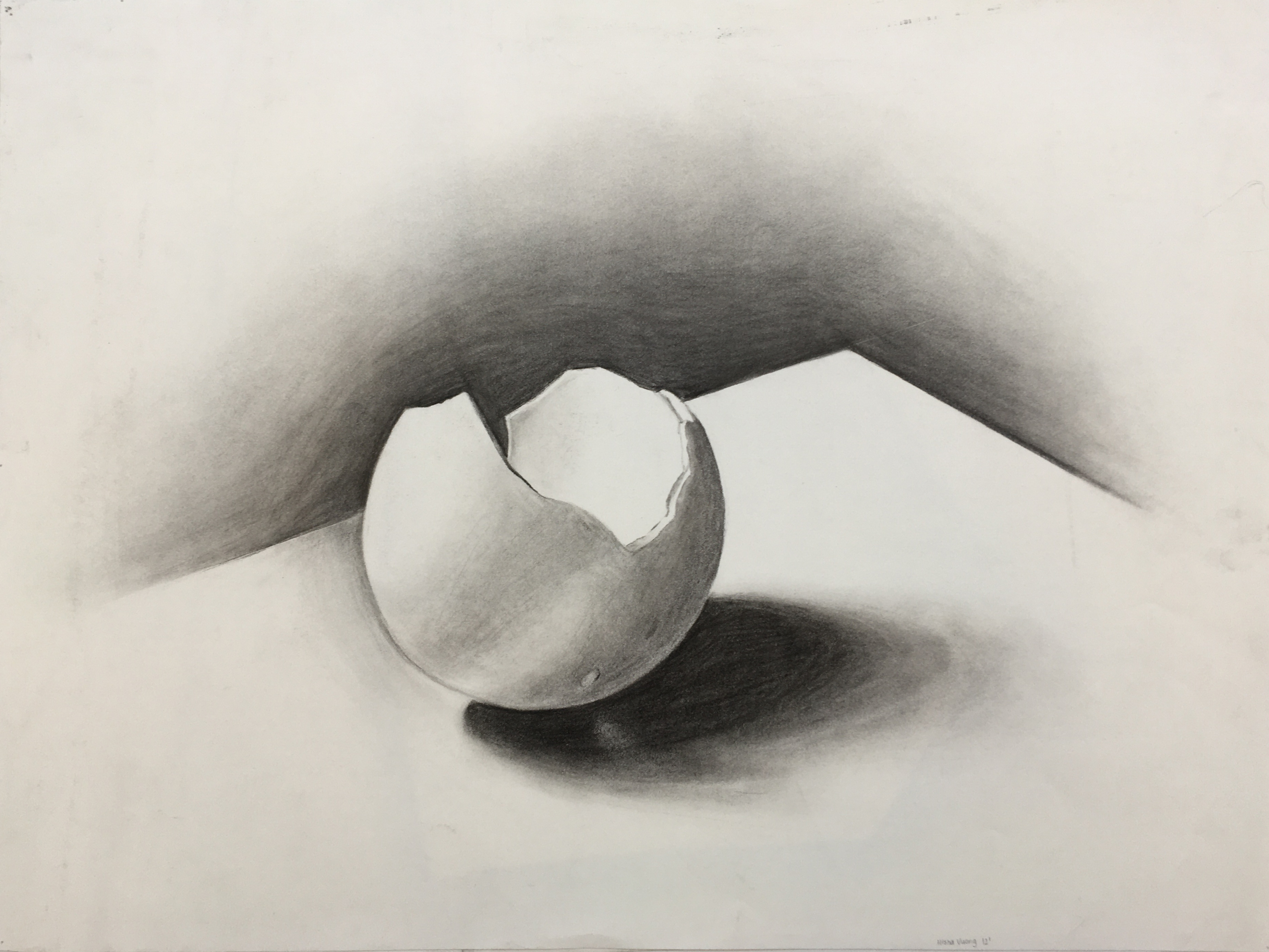
Student Drawings in Charcoal. 2011
Charcoal is arguably the oldest of drawing media used by humans going back over 20,000 years. It has several advantages over other drawing media. You can achieve a rich black at one end of the value scale. Also, it can be blended into the subtlest of tones, while also being able to be scrubbed into the paper so you can erase out the areas you want revealed. That is much like drawing in reverse! Using that technique, which I call a “reverse-out” drawing, you can achieve amazing results in a matter of a few hours at the drawing table. To use a graphite pencil and create a similar visual illusion would take days, instead of hours.
Because of the subtleties of the medium, charcoal is a favorite of artists producing figurative drawings. Charcoal clubs were popular venues for professional and aspiring amateur artists to draw from the nude or partially draped model. Today, figure study sessions and classes are still available for artists to learn to draw human anatomy and to learn the aesthetics of this specialized art genre. Charcoal as a medium is a great choice for portraits and figurative work.
The preferred erasers for charcoal drawing are the kneaded eraser and the white plastic eraser, each performing specific tasks. The kneaded eraser works well for subtle and detailed erasing when made into a point. Flattening out this eraser allows for broad areas to be lifted from the paper. The pressure from your hand or fingers determines the amount of the drawing removed. With enough practice, you can become adept at removing very specific area and amounts of the drawing with this eraser. It really is a versatile tool! The white plastic eraser can also be used for detail work if it is trimmed to the desired size and shape using a blade, and held in a brass ferulle. You can even draw with the eraser in this way. Of course, you can purchase a white plastic eraser that is in the shape of a pencil and use that to erase and draw as well. The white plastic eraser also is used for firm scrubbing of the charcoal to remove it. Again, another versatile tool for the artist with some specific uses.

Student Reverse Out Charcoal Drawing (using kneaded and white plastic erasers). 2018

Illustration using brushes and carbon dust (charcoal/Conté mixed powder). 1982
Conté Pencils and Crayons
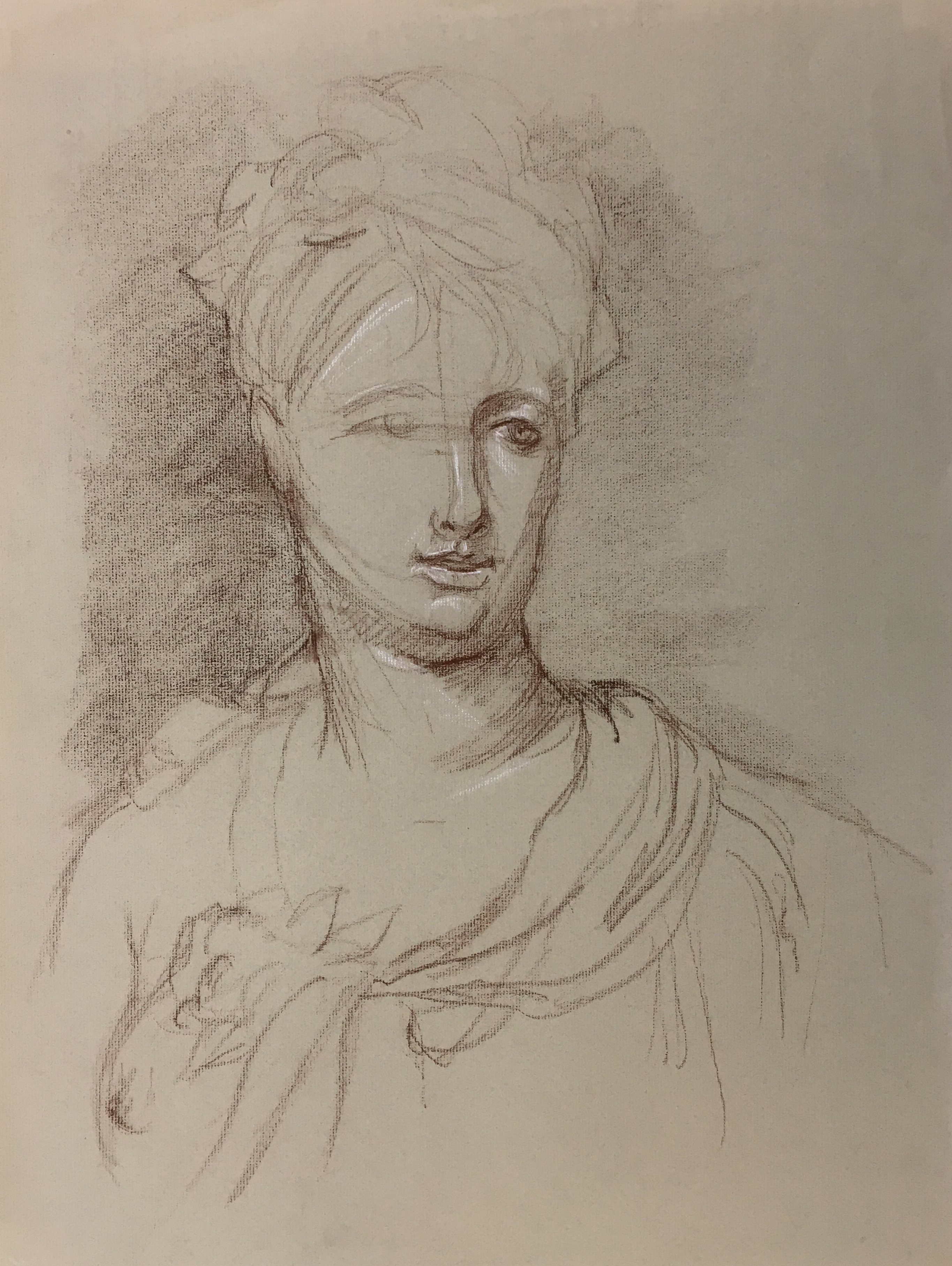

Drawing demonstration. Conté (white and burnt sienna). 2008 - 2011 Demonstration drawing from live model. Conté. circa. 1995
The characteristics of Conté are similar to charcoal, yet there are some differences that should be noted. The size of the Conté sticks is ideal for both drawing with the end, as well as drawing from the side of the stick. Conté comes in different levels of hardness as does charcoal. I prefer the softer sticks since I find it easier to get a range of tone and textures on the paper surface. Drawing directly with the sticks yields a drawing different from one that is blended and pushed into the paper with brushes, paper stumps, or blending tools. Conté is harder to erase than charcoal, yet is more permanent on the paper surface. Both charcoal and Conté benefit from using a fixative to help prevent smudging and lifting of the drawing. To protect and preserve a finished charcoal or Conté drawing, it is best to place it under glass after placing a properly sized cut mat around the drawing.
.jpg?revision=1&size=bestfit&width=629&height=814)
Charcoal reverse out drawing by student. circa. 2015

Variety of media with compressed charcoal jet black (on the right)

Demonstration using compressed charcoal (some scrubbing and blending of the charcoal). circa. 2016

Charcoal drawing demonstration (without blending). Conté. 2018

Student Charcoal Drawing on Newsprint. 2012
Charcoal student drawing. 1978

Charcoal "Painting"
Charcoal and pastels have a unique ability to appear as either a drawing, or as a painting depending on the application. The beautiful drawing above is more like a charcoal painting in the strokes and subtle shifts in value.
Figure Drawing
Drawing the human figure is a difficult task for beginning artists. The complexities of the forms may frustrate the student since the human body is all so familiar. We see our heads, hands, and feet regularly, but try to draw them accurately! A thorough study of the anatomy for artists helps to unlock the mysteries behind drawing this challenging subject. If you really are intent on mastering drawing the human figure, don’t give up. Keep practicing and carefully observing the model. Make connections with the textbooks and other resources and your observations of the figure in the drawing studio. First learn to recognize the bony landmarks. Next, study the muscles, tendons, and fat pads – both the underlying anatomy as well as the surface anatomy. Study the human figure proportional systems associated with the male, female, and children. Do not neglect the most challenging areas of study – head, hands and feet. Devote extra practice time to drawing those parts of the body. Perfect practice makes perfect, so use reliable sources to help guide you in your figure studies.
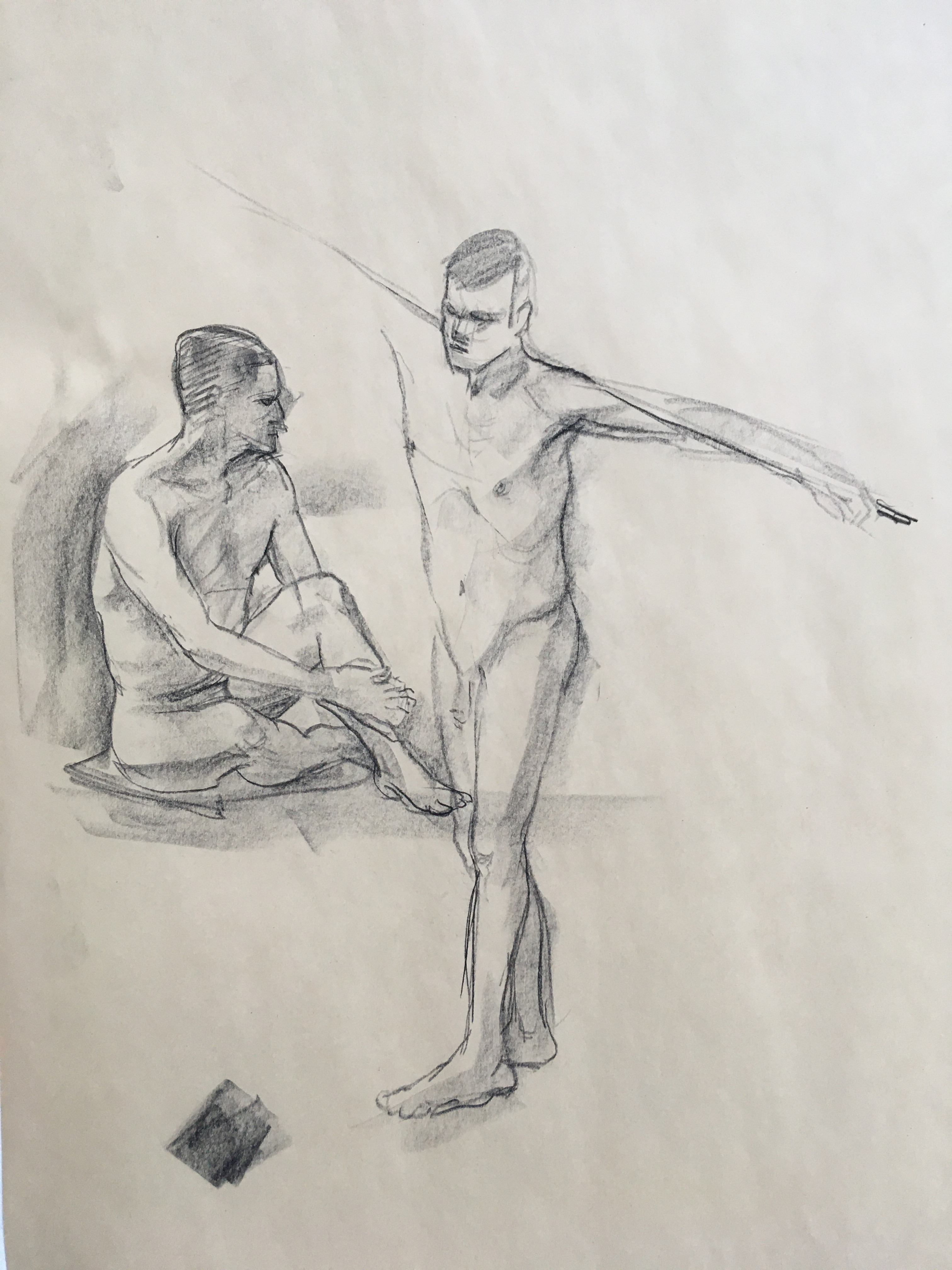

The quick gesture drawing is a staple of the figure drawing studio. In my drawing studio, drawings from the model are timed at 2:00 minute intervals, 5:00 minute intervals, 10 minutes, with a maximum of 20 minutes per model pose. Longer poses can combine 20 minute poses into 40, 60, 80 minutes combined as needed. The above drawing on the left is from the 5:00 minute poses. The drawing on the right demonstrates ways of using geometric shapes to better capture the quick gesture.


The artists of the 1800s were often banned from drawing from nude models. Here are two charcoal drawings from that era.
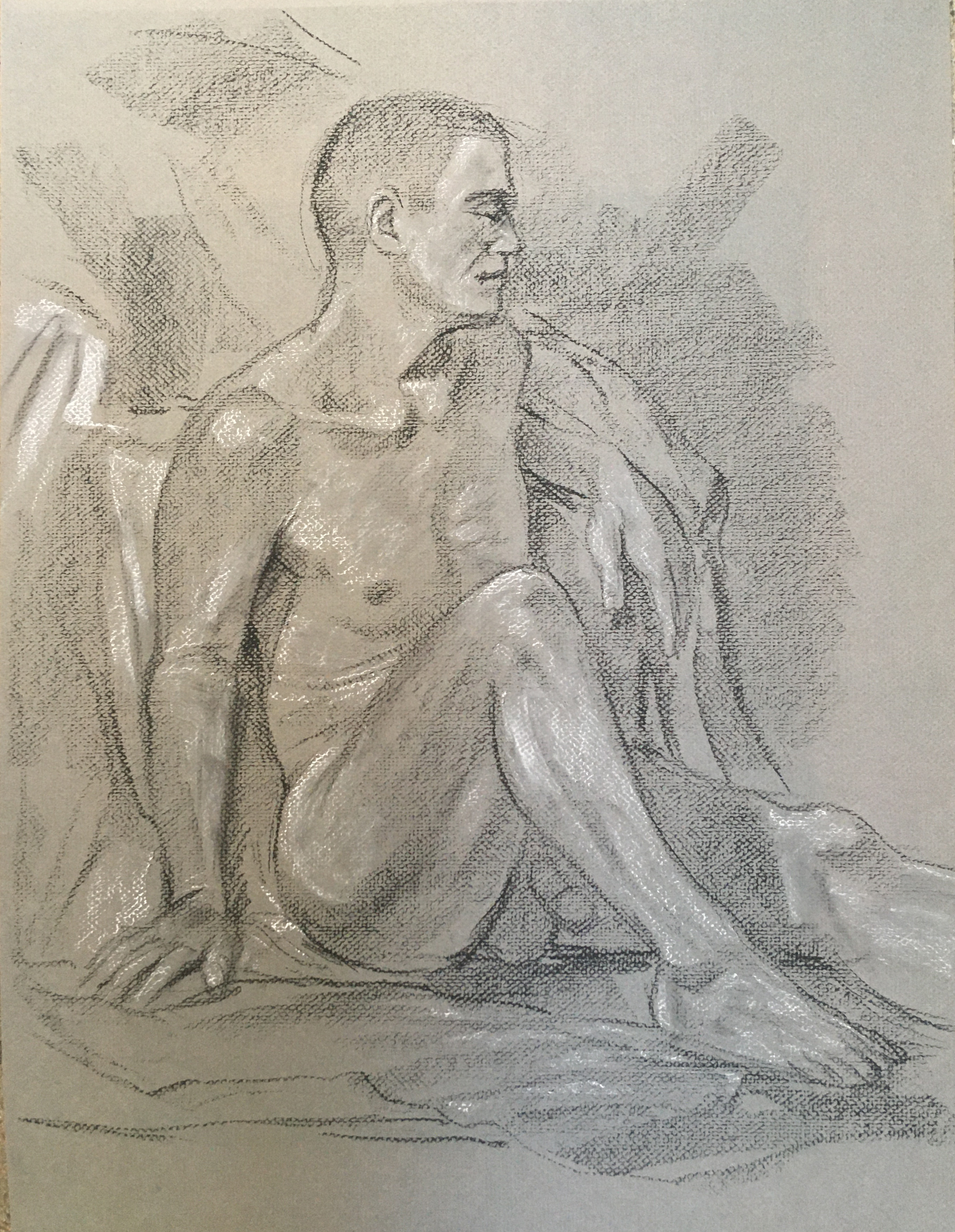
This is a longer drawing demonstration of about 40 minutes. Black and white Conté are used with a middle value of gray established by the paper. 2019
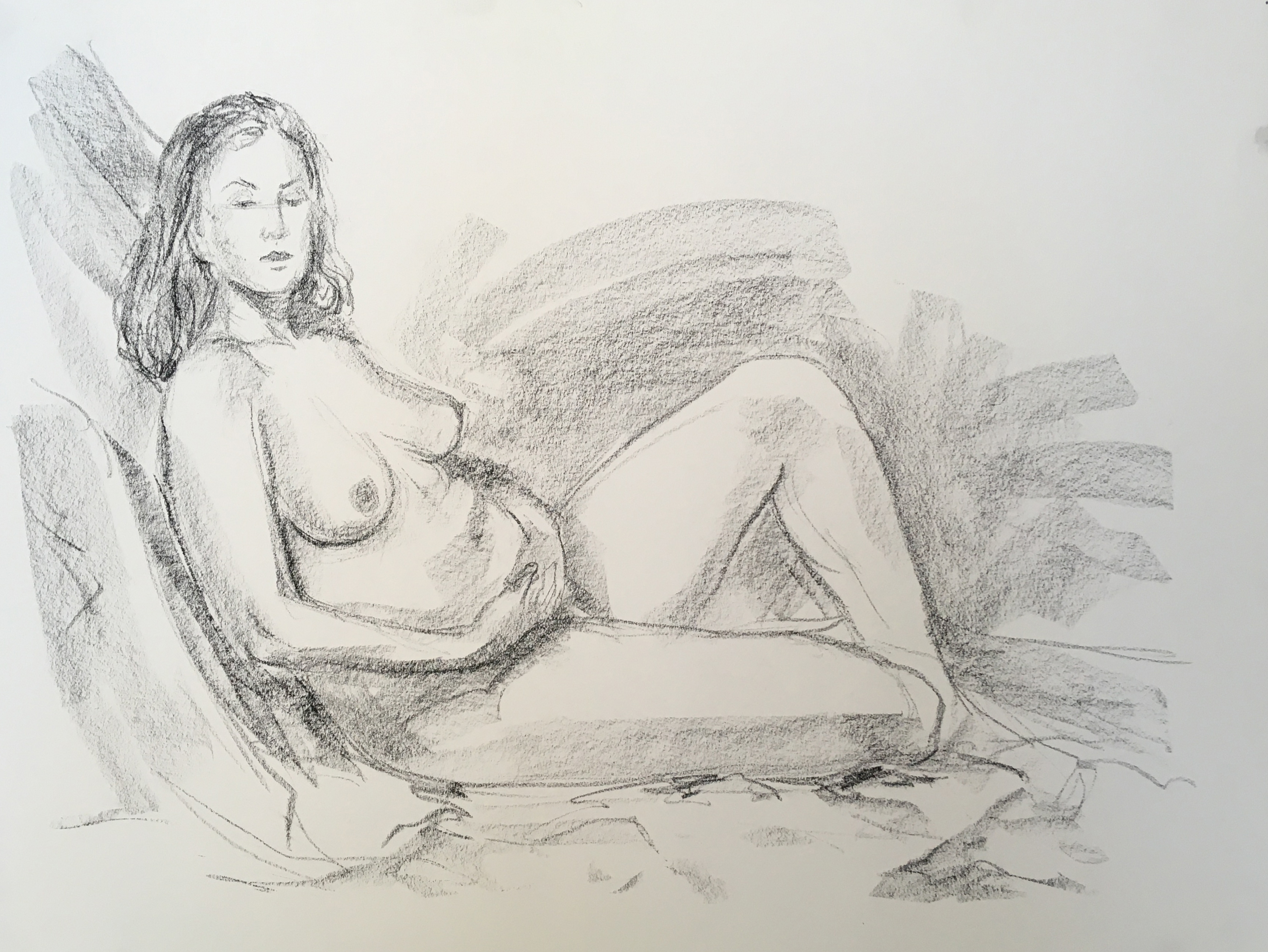
20 minute drawing demonstration using Conté. 2019
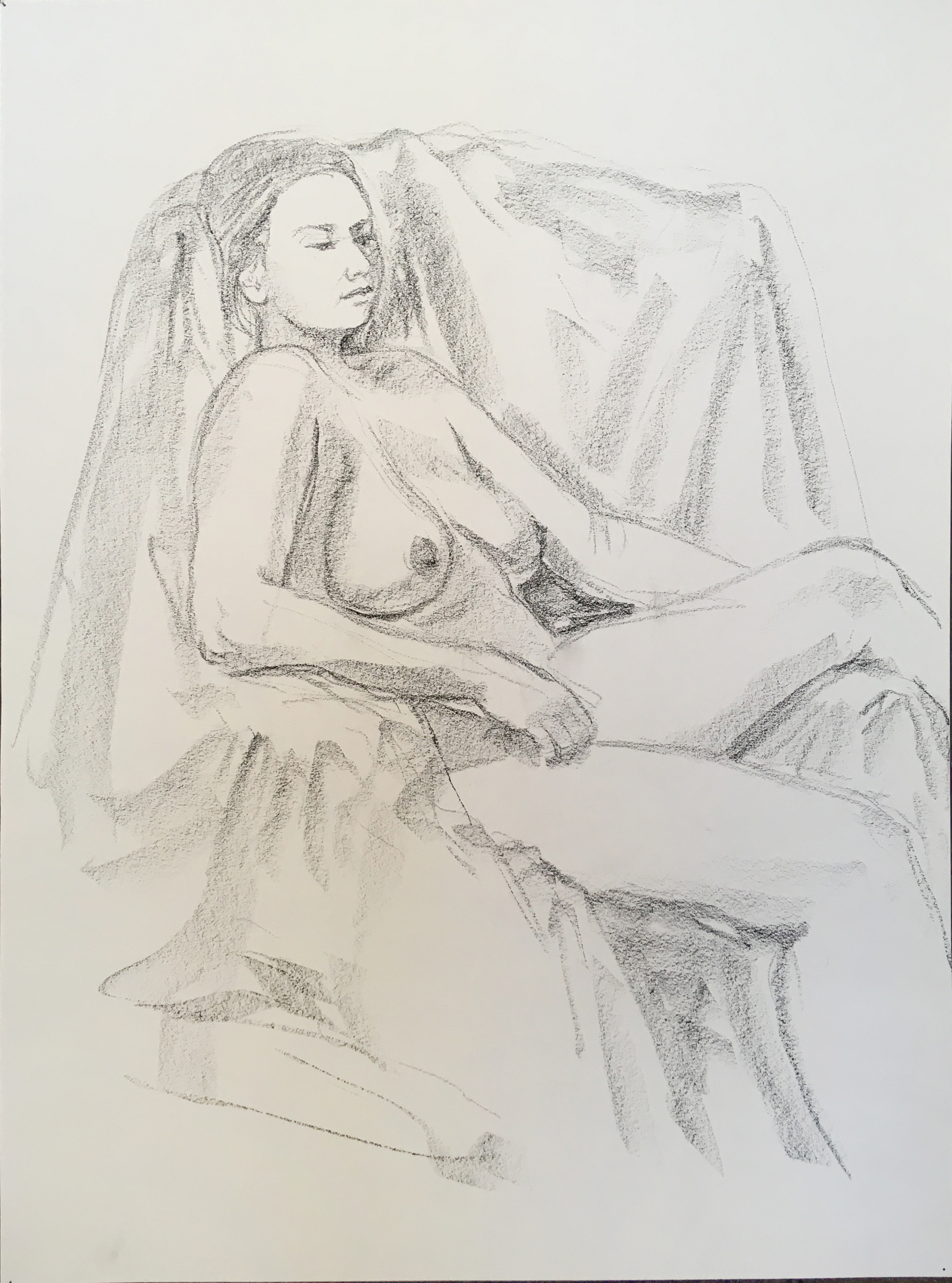
10 minute drawing demonstration using Conté. 2019

